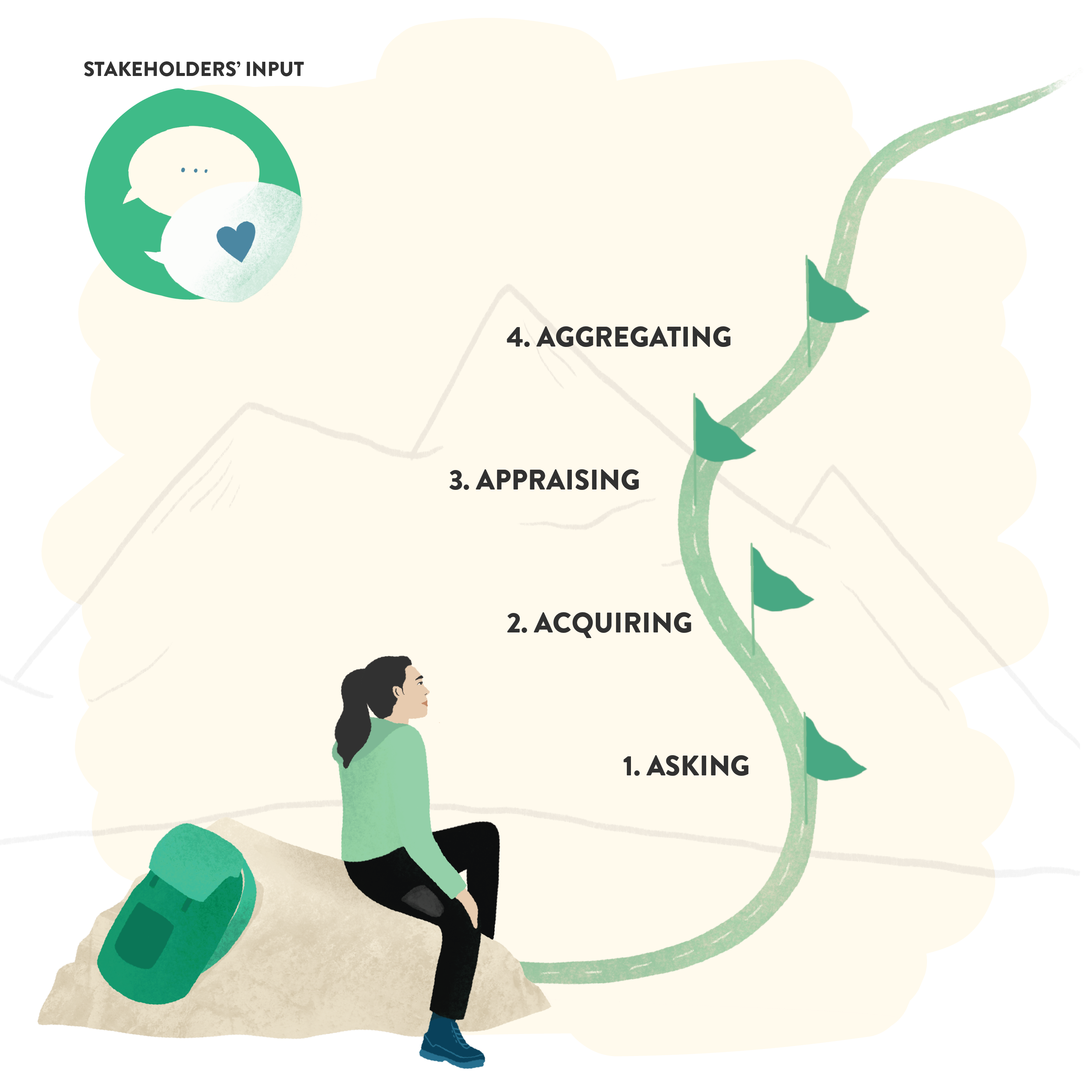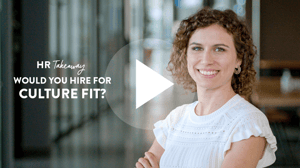#Evidence Based HR #Blogpost
Stakeholders’ perception of a problem and solution affect how these will work out, so discover how to use it in evidence-based HR decisions.
Episode 5: The Evidence-Based HR Backpack – Stakeholders’ input
When subjective evidence is good: stakeholders’ input in evidence-based HR
Just like all of us, Evi, HR Manager of the international bicycle manufacturer BisonBikes, is confronted with the current pandemic. Today all their employees who can, work from home. A part of the population still works on site to keep the bicycle production running. Meanwhile, Evi is thinking about how they’ll organise once things change: in the past, there has been some flexibility at BisonBikes in terms of working from home, although it was rather limited. What’s the best way for Evi to decide on how to organise work in the post-Covid world?
Today, the discussion around remote work - and work design in general - is one of the most burning issues within HR. A few years ago (in 2013), Yahoo! experienced how critical the topic is when they banned all work-from-home and asked all employees to be physically present in the office during work hours. Although well-intended, with the aim of encouraging collaboration, people simply didn’t like the directive. Not only did employees disapprove, so did shareholders and even competitors. In the end, the decision didn’t turn out well for Yahoo!. Maybe because they lost sight of the fact that people’s perception and embracing of a decision can influence how well it works.
HR decisions impact on people, direct or indirect, positive or negative, big or small. Many groups can be affected – employees, managers, board members, clients, suppliers, etc. All of whom are stakeholders, and you need their input to make evidence-based HR decisions.
This impact causes Evi some concern, given that she’s not sure on how to tackle this delicate matter in the right way. Let’s reassure her.
Stakeholder evidence is subjective – a good thing

After the problem definition, Evi took a look at this through the first three sources in evidence-based HR: scientific research, organisational data and professional expertise. These sources are evaluated based on how objective they are.
However, for people-related decisions, the subjective perceptions of those affected are important. So, if stakeholders want the solution to work, they really need to get into the program and collaborate. You can have the best evidence in the world that working in the same office is more productive, but if people don’t like it, they’ll find workarounds or, even worse, quit.
Besides being practical, it’s also ethical to gather input from those affected by a decision. That way, you’ll understand how the measures will play out for them.
Subjective stakeholder evidence is both practical and ethical in people decisions.
When we look for input from stakeholders, we look for:
- What they value and desire, what they consider important
- What they are concerned and worried about
Putting stakeholders’ input to good use
Stakeholders’ input is helpful throughout the 6 As process of decision-making (ask, acquire, appraise, aggregate, apply and assess). We’ll cover the last two steps in a separate article, however, here we’re going to focus on how stakeholders’ input helps throughout the first 4 As:

-

1. Asking: identify the right questions
Let’s say that the pandemic is over and that Evi’s company BisonBikes allows more work-from-home, but managers feel this causes delays in project delivery, and they want all employees to be in the office during core hours.
Evi needs to turn the assumptions into questions. She would ask:
- Is work-from-home causing delays in project delivery?
- Does a core-hours policy speed up project delivery time?
Several groups of stakeholders will be affected by the answers to these questions, primarily employees. Evi can run the questions by them, for example:
- “Do you agree that projects could be delivered faster?”
- “Would being present in the office during core hours help you to gain speed?”
You get the drift.
-

2. Acquiring: gather evidence from stakeholders
First off, who do you ask for evidence? Map out all your stakeholders: we normally all have a biased perception of who is affected by a decision, so ask for someone else’s help and maybe use a dedicated method. After mapping her stakeholders, Evi realizes they are too many to gather evidence from all. The solution is to identify those who represent a broader group or select those who are most affected by her decision – people with a long commute, for example.
Second, what do you ask stakeholders? After clearly outlining the problem and the proposed solution, Evi should ask them about the downsides and what alternative solutions they see, to confirm that she has the best possible solution in core office hours.
Finally, how do you ask? As in the case of practitioners’ evidence, collect qualitative (through interviews or focus groups) or quantitative input (through surveys). Evi goes for both. For interviews or focus groups she makes sure the moderators are skilled in capturing information objectively. For surveys, it’s key to have a representative sample of respondents – they must have the same characteristics as the entire group of stakeholders, e.g. in terms of gender or seniority.
-

3. Appraising: learn from stakeholders
Input from stakeholders must reflect people’s values, feelings and perceptions. They should be able to freely express their views and the sample should be representative. Additionally, appropriate stakeholders’ evidence must be:
- practically relevant – The stakeholders who have the power to influence the outcomes of the decision have been asked for input, e.g. senior leaders in BisonBikes.
- ethically relevant – The stakeholders who are negatively affected by the decision have been taken into account, e.g. Evi’s colleagues who have a long commute.
-

4. Aggregating: stay true to stakeholders’ input
While you work with the input and try to summarise it, it’s likely that your subconscious (or conscious) preferences will influence what you decide to keep or leave out. To avoid this, honestly present all that has been expressed and include quotes and original words as much as possible.
If Yahoo! had asked employees (the most affected stakeholders) about the decision to end work-from-home, they might have collected input like “[…] it’s outrageous and a morale killer.” That might have helped them reach another decision with better outcomes.
-
Stakeholders’ input helps interpret evidence from other sources
By supplementing the first three sources of evidence-based HR (scientific research, organizational data and professional expertise) with the subjective views and feelings of stakeholders, Evi arrives at a substantiated and supported decision.
Stakeholders’ input is subjective, but it’s the framework to use when interpreting all other evidence, for both practical and ethical reasons.
Follow our page to read about how to apply all the evidence you’ve collected and how to assess the outcomes of your decisions.
Enjoy the journey.
For more inspiration and freely available resources, check the websites of our partners CEBMa and ScienceForWork.
Would you like to interact about EBHR and learn together with other people? Then you’re welcome to join our knowledge sharing forum for EBHR-learners on Facebook, and our open workshops. We're also happy to provide a custom session for your organisation, online or offline.
Iulia Cioca & Edward Vanhoutte
Iulia, a graduate in Work and Organizational Psychology from the University of Valencia, with a diverse educational background spanning Romania, Austria, Italy, and Canada, specializes in HR advisory. She is HR Scientist at Balance HR, dedicated to evidence-based HR practices, and a CEBMa fellow and PhD candidate. Edward, the managing partner of Balance HR and a fellow of CEBMa, specializes in building high-impact HR teams and promoting evidence-based HR practices. In addition, he has a keen interest in graphics and societal initiatives.



